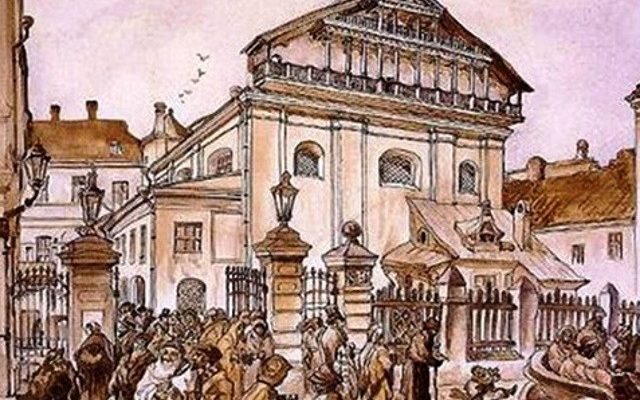Remains of the Great Synagogue of Vilna were recently exposed, 70 years after it was destroyed by the Nazis during the Holocaust.
Over seven decades after being destroyed during the Holocaust, two Jewish ritual baths (Mikvas), which were connected to the Great Synagogue of Vilna, were exposed by archeologists.
In July, a team of Israeli, Lithuanian and American archaeologists unearthed the remains of the two ritual baths that were used by congregants at the Great Synagogue of Vilna.
The synagogue, which was the heart of Vilna’s large Jewish community for hundreds of years, was completely destroyed in the Holocaust, but evidence of underground spaces discovered in a study carried out last year led to the excavation of the site and the exposure of the ritual baths.
The Great Synagogue of Vilna, built in the 17th century in Baroque-Renaissance style, served as a community gathering place and a center of Torah study. It actually included 12 smaller synagogues and study halls (Batei Midrash), ritual baths, the community council building, Kosher meat stalls, the study hall of Rabbi Eliyahu (the Genius, or “Gaon,” of Vilna), and more.
After hundreds of years of existence, the entire Jewish community of Vilna was destroyed and the Lithuanian Jews’ most holy place was looted and burned by the Germans. The standing remains were completely destroyed by the Soviet authorities who built a school in its place.
Understanding ‘Jerusalem of Lithuania’
“Most of the historical descriptions of the Great Synagogue in Vilna and the community courtyard (Shulhoyf) relate to the Great Synagogue and the surrounding prayer halls. Until now, we have found little information about the bathhouse and Mikve building of the Jewish community, a community that comprised almost half of the city’s population,” explained Dr. Jon Seligman of the Israel Antiquities Authority (IAA), who leads the research team.
The excavation has followed an architectural plan from the end of the 19th century that was discovered in the municipal archive of Vilna and included a plan for the restoration of the ancient bathhouse by the community. According to the plan, the bathhouse consisted of two main floors, many rooms, and a large service wing. It was also possible to identify two installations that were built as ritual baths.
This plan guided the researchers during the archeological dig, which also entailed a ground penetrating radar survey.
Seligman was joined by Mantas Daubaras of the Lithuanian Cultural Heritage Organization and Prof. Richard Freund of Hartford University. The two installations discovered are of the final phase of the Mikva’ot dated to the early 20th century. They have tiled walls and floors, steps leading to the pool and an Otzar, an auxiliary pool in which rain water is collected for the Mikve, in order to make it suitable for ritual purification.
“These discoveries add a new dimension to the understanding of the daily lives of the Jews of Vilna, and will certainly provide a new focus for understanding the lost cultural heritage of the Jewish community of Vilna, the ‘Jerusalem of Lithuania,’” the researchers said.
By: World Israel News Staff




